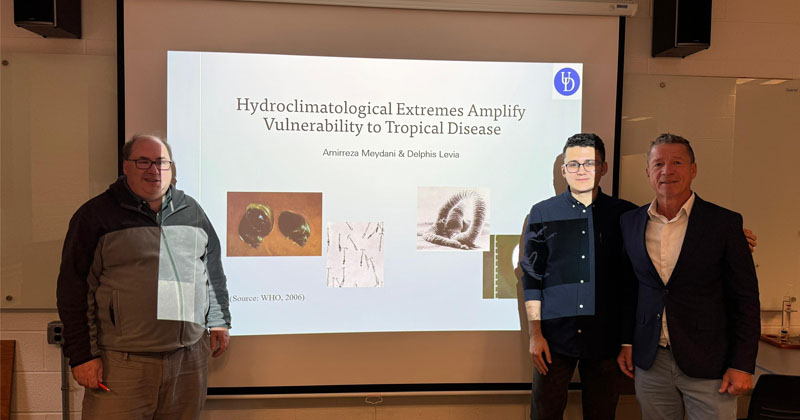
Category: Student Profiles

College of Earth, Ocean and Environment presents study at brown bag seminar
October 29, 2025 Written by Amirreza Meydani and Delphis Levia
Delphis Levia, professor of ecohydrology, and Amirreza Meydani, College of Earth, Ocean and Environment doctoral candidate, presented the findings from their study, “Hydroclimatological Extremes Amplify Vulnerability to Tropical Disease,” at a brown bag seminar hosted by the water science and policy program.
Increased hydrological variability has reshaped the rate and geography of disease transmission. Schistosomiasis, a neglected tropical disease and the second-most prevalent parasitic disease after malaria, is no exception. In Brazil, weather variability has altered the frequency and intensity of extreme events, influencing the ecological suitability of snail species that serve as intermediate hosts for Schistosoma mansoni.
In this study, we developed a machine learning-based Species Distribution Model (SDM) using daily gridded weather data and extreme climate indicators to predict habitat suitability for three key Biomphalaria species. To better understand the drivers of change, we incorporated SHAP (SHapley Additive Explanations) to quantify and rank the influence of individual climate variables on model predictions, allowing us to trace spatial and temporal shifts in suitability.
Precipitation seasonality, multi-month drought indices, surface absorbed solar radiation extremes and diurnal air temperature range were the highest-ranked drivers, though their influence was not uniform across snail species. B. glabrata was most responsive to seasonal recharge, while B. straminea showed resilience to variability and often persisted in man-made habitats. B. tenagophila was more constrained by drought and radiation stress.
Spatial comparisons between 1995 and 2020 indicated expansions and contractions in various states, with new hotspots emerging in southeastern and central Brazil, while habitat suitability declined in drought-prone regions, such as in the state of Pernambuco. These results demonstrate that climate extreme events, in addition to long-term baseline changes, drive the spatially heterogeneous redistribution of Biomphalaria habitats. Also, our findings highlight the need for species-specific monitoring, integration of water infrastructure management and forward-looking surveillance strategies that address both climate variability and landscapes modified by humans.
Funding note: This work was supported by the U.S. National Science Foundation (award number BCS-2436990).
